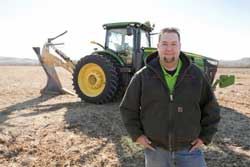|
Jonathan Spruell Monitors Farm Operations Using Smartphone
2014 Precision Ag Farmer Of The Year
REGINA LAROSE
MIDAMERICA FARMER GROWER
MOUNT HOPE, ALA.
Jonathan Spruell, of Mount Hope, Alabama has been named the 2014 Conservation Systems Precision Agriculture Farmer of the Year at the 17th Annual National Conservation Systems Cotton & Rice Conference, Southern Corn & Soybean Conference and the Southern Precision Ag Conference. Spruell was recognized for his achievements at the conference which was held in Tunica, Mississippi on January 15-16, 2014.
After college Spruell came back to the farm and has been an active partner in Spruell Farms for a little over 10 years. “I tend to lean more into the precision side of things that is my forte. That is where I spent a lot of my time, configuring the equipment, getting to know all the data that goes into and out of all the monitors and systems that we operate,” he said.
Producing over 1,000 acres of cotton, 1,700 acres of corn, double crop beans, 2000 acres of wheat and 600 acres of peanuts; Spruell strives to follow a three year rotation. “We have seen a drastic yield bump, input costs are still on the rise but as we can manage as long as we really manage our inputs,” explained Spruell.
“We try especially with our peanuts, to get to a three-year rotation. We have found that cotton or wheat follows peanuts really well. Wheat does really well; you have to manage your nitrogen because you can get an excess of nitrogen; that causes a lot of problems. A three year rotation is where we like to be,” he said.
“We are deeply, deeply rooted in the precision ag side of things. All of our planters are controlled via auto steer GPS. We have variable rate capabilities on all our planters. We run three 24 row planters. All of our equipment, variable rate technology is coupled with the RTK guidance system,” explained Spruell. Spruell Farms has two base stations, which it owns, operates and maintains.
Spruell also pulls in signals from Glonass satellites to increase vertical accuracy. “That is what allows us to be able to run drainage work with a RTK receiver. We can lay out a grid or however you choose to install your pipe. In the Midwest they will grid an entire field and run every 50 foot or every 100 foot centers. In our area, the way our terrain is, we tend to run in a crows foot style and around the side of hills. Our elevation changes drastically in short distances. Now, you can take this RTK guided implement, plot a course that takes into consideration the starting point and the ending point, it will figure the slope for you,” stated Spruell.
Spruell irrigates about 800 acres. “We do mostly center pivot. We have a small amount of flood irrigation on fields we leveled. We use poly pipe. The set up and prep work is really expensive but as far as year to year irrigation cost, it is relatively inexpensive.”

Named as 2014 Conservation Systems
Precision Agriculture Farmer of the Year at the
17th Annual National Conservation
Systems Cotton & Rice Conference is Jonathan
Spruell of Mount Hope, Alabama.
Photo by John LaRose, Jr.
Fertility efficiency and consistency can save 25 percent. With precision ag equipment Spruell gets accurate yield maps determining where in the field the good and bad spots are located. Overlaying soil type maps he can determine which areas in the field to collect soil samples. Using the recommendations from the ag lab Spruell writes a fertilizer prescription and applies the product using variable rates. “It evens out the playing field. It makes the field more consistent, your fertility is more consistent from side to side,” added Spruell.
Poultry litter is Spruell’s main fertilizer. “On our cotton we run about a two ton rake of poultry litter; on our corn land we try to run in the three ton range. We try to apply every year.”
Using the John Deere 7760 roller cotton picker configured on a 3060 skip saves time and money. “It is a six row picker. We run a skip row pattern because that increases our productivity by about 25 percent daily and it decreases our input costs by about 27 percent. We tend to apply about 27 percent less seed therefore 27 percent less technology. That has been a major savings for use and we have not noticed a yield decrease over 30-inch solid, we have actually noticed a yield increase,” he said.
Spruell keeps an eye on his operation with a Smartphone. “All of our tractors and harvesters have Smartphone capabilities. I can actually see what my operator is seeing on his monitor from my phone at anytime. I can pull up his monitor from my phone and diagnose the issue. If it needs further assistance from a technician, I can get a John Deere technician involved,” concluded Spruell.∆
REGINA LAROSE: Associate Editor, MidAmerica Farmer Grower
|
|